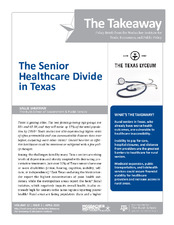| dc.creator | Sherman, Sallie | |
| dc.date.accessioned | 2021-05-04T15:44:49Z | |
| dc.date.available | 2021-05-04T15:44:49Z | |
| dc.date.issued | 2021-04 | |
| dc.identifier.uri | https://hdl.handle.net/1969.1/192866 | |
| dc.description | Texas is getting older. The two fastest-growing age groups are 85+ and 65-84, and they will make up 17% of the total population by 2050. Texas seniors are also experiencing higher rates of often-preventable and non-communicable diseases than ever before, outpacing most other states. Central barriers to effective healthcare could be overcome or mitigated with a few policy changes. The author is a Bush School student whose work was supported by a research fellowship from The Texas Lyceum. | en |
| dc.description.sponsorship | The Texas Lyceum | en |
| dc.language.iso | en_US | |
| dc.publisher | Mosbacher Institute for Trade, Economics & Public Policy | |
| dc.relation.ispartofseries | Volume 12;Issue 3 | |
| dc.rights | Attribution-NonCommercial-NoDerivatives 4.0 International | en |
| dc.rights.uri | http://creativecommons.org/licenses/by-nc-nd/4.0/ | |
| dc.subject | healthcare | en |
| dc.subject | aging | en |
| dc.subject | Texas Lyceum | en |
| dc.title | The Senior Healthcare Divide in Texas | en |
| dc.type | Article | en |
| dc.contributor.sponsor | Bush School of Government and Public Service | |
| local.department | Other | en |



